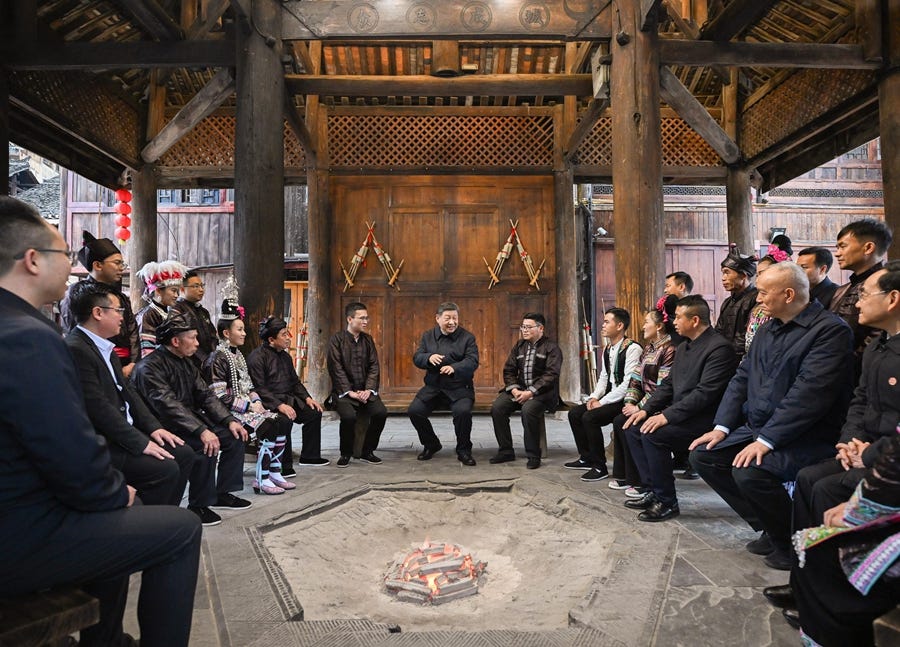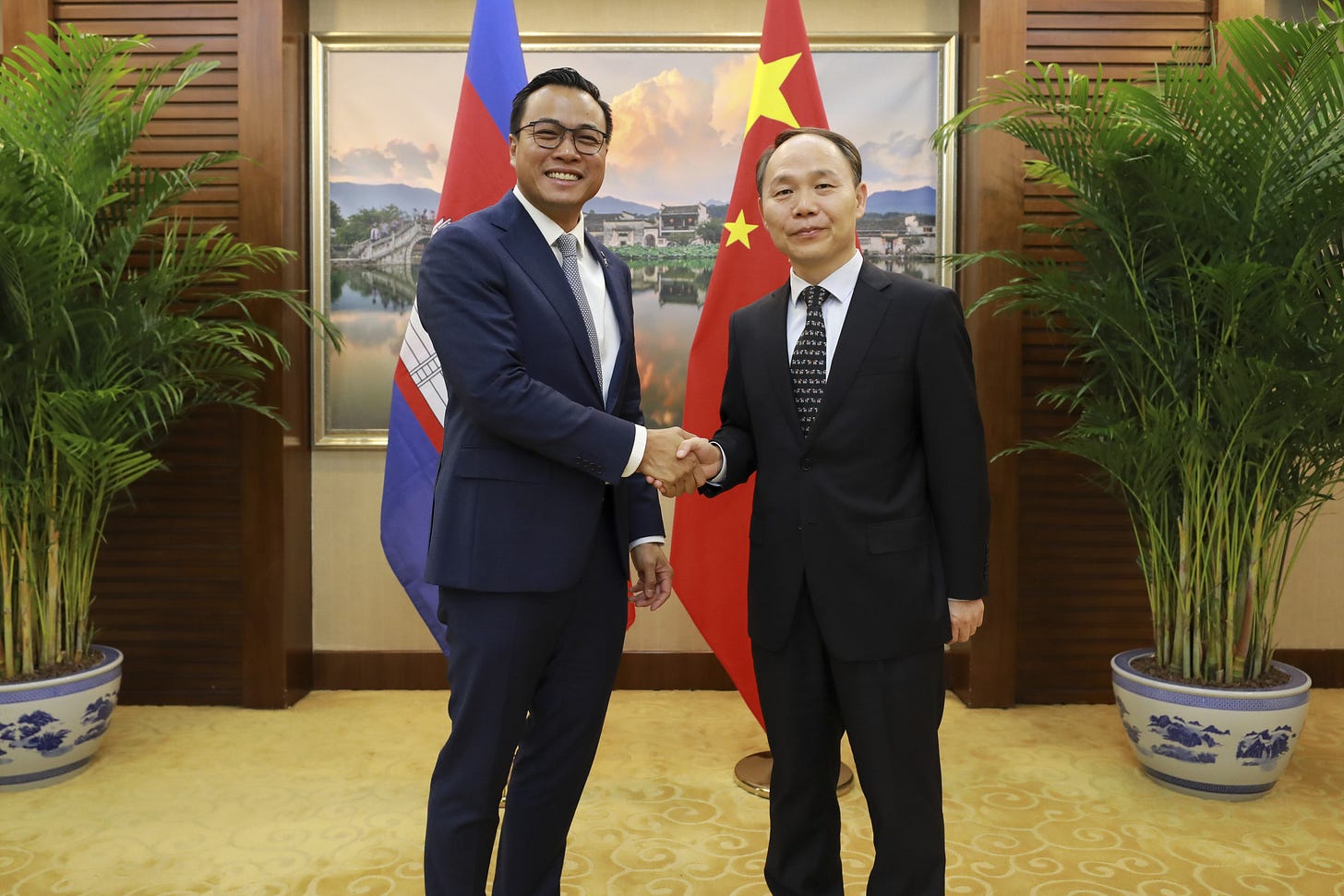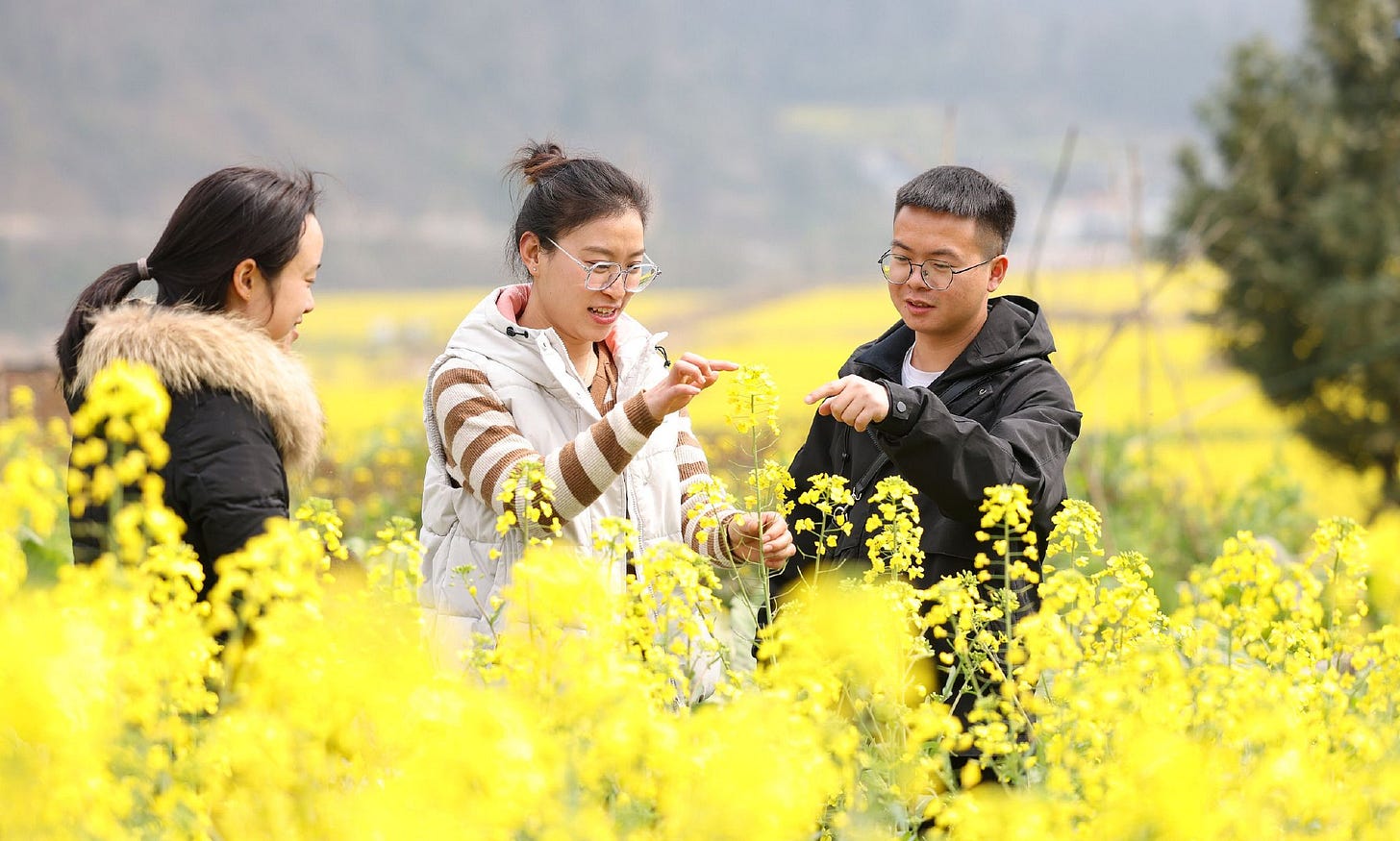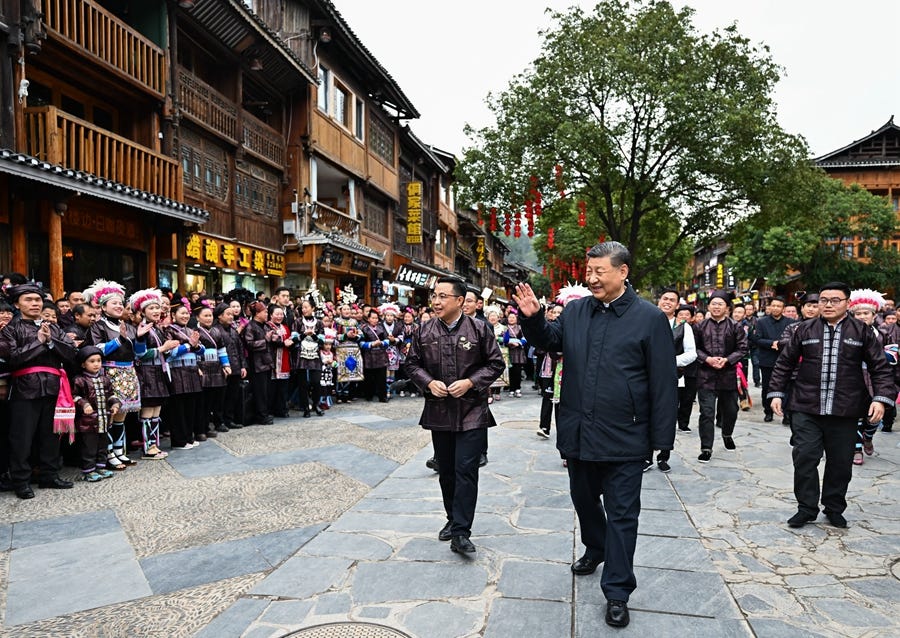The Harvest: This Week in Rural China – Dispatch No. 14 (21 March 2025)
Xi Jinping's Guizhou visit, Shitanjing’s transformation, China-Cambodia’s Fish-Rice Corridor, and rural revitalisation.
This week, The Harvest brings you a snapshot of some of China’s most pressing agricultural and cultural challenges:
The Complex Reality of Xi Jinping’s Visit to Guizhou: A Glimpse into the Future of Rural China
From Coal to Culture: Shitanjing’s Bid for Transformation Reflects Rural China’s Changing Landscape
China and Cambodia Launch “Fish-Rice Corridor” Initiative
Chongqing’s Rural Poverty Alleviation: Examining the Claims of Rising Income and Employment Growth
Han Jun’s Vision for Building Future Leaders to Drive Rural Revitalisation
I always welcome your insights, as your feedback helps shape the direction of every dispatch. Please share your thoughts in the comments below or reach me at nathan@thisweekinruralchina.com.
As always, The Harvest remains free for all readers. If you find value in these dispatches and want to support the continued work behind them, consider becoming a paid subscriber. Your support helps sustain this project and ensures we can continue publishing consistently.
Now, let’s dive into this week’s stories:

The Complex Reality of Xi Jinping’s Visit to Guizhou: A Glimpse into the Future of Rural China
From 17th to 18th March 2025, President Xi Jinping’s visit to Guizhou underscored the region’s key role in the government’s broader strategy of “high-quality development” (高质量发展) and the push for “Chinese-style modernisation” (中国式现代化). As Xi toured the province, including the minority-majority Miao and Dong Autonomous Prefecture in the southeast, official rhetoric stressed rural revitalisation, ecological preservation, and economic transformation. However, beneath the surface of this carefully crafted narrative lies the more complex reality faced by Guizhou’s rural communities.
Xi’s official tour, which included stops in the picturesque Dong village of Zhaoxing, was marked by his personal engagement with the region’s cultural and historical identity. Traditional songs and dances, performed in full ethnic dress, served as potent symbols of a government committed to preserving “ethnic diversity” (民族多样性) while promoting economic progress. Xi praised the protection of the Dong people’s intangible cultural heritage, including their iconic “Dong Song” (侗族大歌), a polyphonic choral tradition. The emphasis was clear: China’s future is rooted in its past, and Guizhou’s ethnic richness will play a significant part in this process.
However, the reality for many in rural Guizhou is far from as harmonious as the government’s portrayal. Despite the emphasis on “ecological advantages” (生态优势) and “green development” (绿色发展), Guizhou remains one of China’s most impoverished provinces. The region’s economy has long depended on agriculture and mining, industries often associated with environmental degradation. As Xi pushes for a more “modern” economy—emphasising digital and renewable industries—there are concerns about whether these initiatives will reach the more remote areas or merely deepen existing divides.
While Guizhou’s natural beauty and ethnic diversity make it a prime candidate for cultural tourism, this sector has often struggled to provide sustainable income for local communities, as widely discussed on This Week in Rural China (here, here, and here). Xi applauded efforts to commercialise traditional crafts, like the wax-resistant dyeing practised by the Dong people, but whether these industries can offer long-term, meaningful employment to rural workers remains contentious. For many in these communities, the dream of rural revitalisation appears distant, overshadowed by the daily struggles of subsistence farming and limited access to services.
Additionally, Xi’s rhetoric on governance and the role of the Communist Party in rural development signals an increasing centralisation of power. His call for a stronger Party presence in local governance, particularly through rural Party branches, raises questions about the extent to which local autonomy will be respected. As economic pressures mount, rural Guizhou finds itself caught between the promises of modernisation and the harsh realities of a rapidly shifting political and economic landscape—where key decisions rest in the hands of distant authorities.
While Xi’s “high-quality development” agenda promotes technological and infrastructural progress, it remains to be seen whether these initiatives will truly empower Guizhou’s rural residents or merely serve as another cog in the machinery of state-driven transformation. In a country that continues to wrestle with the tension between development and preservation, Guizhou stands as both a model and a cautionary tale for the future of rural China.
From Coal to Culture: Shitanjing’s Bid For Transformation Reflects Rural China’s Changing Landscape
This week, Shitanjing, a small mining town in the Ningxia province, has been making headlines not for its coal mines but for its unexpected transformation. Once known as “the little Shanghai of the Northwest” (西北的小上海) during its coal mining heyday, Shitanjing’s story highlights both the decline of traditional industries and the rise of new economic opportunities in rural China.
In the mid-20th century, Shitanjing thrived as a key coal mining hub, rich in high-quality coking coal. The town’s mining operations fuelled China’s industrialisation, particularly in steel production, making it an important player in the country’s economic engine. Shitanjing’s bustling streets, once teeming with coal workers and industrial activity, mirrored the vibrancy of Shanghai, the country’s financial powerhouse, earning its nickname.
However, as China and its export markets transition away from coal and reduce their reliance on fossil fuels, towns like Shitanjing have faced the challenge of economic restructuring. The local coal industry began to decline in the early 2000s as global and domestic pressures to reduce carbon emissions intensified. Many mines closed, leaving the town struggling to adapt to the changing economic landscape.
Now, with government backing and investment, Shitanjing is actively embracing a cultural and tourism-driven transformation. The town is working to preserve its industrial heritage while attracting visitors through initiatives like the “Industrial Heritage Park” (工业遗产公园), which showcases Shitanjing’s history as a coal town with old mining equipment and repurposed factories-turned-museums. Surprisingly, this has appealed not only to traditional tourists but also to those drawn to a post-apocalyptic aesthetic. Additionally, Shitanjing is leveraging its scenic surroundings and rich traditional culture to develop eco-tourism ventures and offer filming locations, generating income from both its natural beauty and industrial past.
Shitanjing is also pushing for development in the agricultural sector, encouraging sustainable farming practices to complement the tourism boom. The local government has launched initiatives for organic farming and rural rejuvenation programmes, aiming to boost agricultural output while promoting environmental sustainability. This kind of diversification has been largely overlooked across much of rural China.
This transformation is part of a broader trend across rural China, where former coal towns and industrial hubs are pivoting to more sustainable and culturally significant industries. As China moves away from coal for economic growth, places like Shitanjing are proving that adaptation and diversification aren’t just a possibility—they’re happening right now.

China and Cambodia Launch “Fish-Rice Corridor” Initiative
In Beijing this week, officials from China and Cambodia convened for the inaugural meeting of the “Fish-Rice Corridor” Cooperation Plan (共同推进“鱼米走廊”建设的合作规划) initiative, further cementing their agricultural partnership. Co-chaired by Zhang Zhili, Vice Minister of Agriculture and Rural Affairs of China, and Prak David, Secretary of State for Cambodia’s Ministry of Agriculture, Forestry, and Fisheries, the 18 March session focused on strengthening bilateral ties in agriculture.
The “Fish-Rice Corridor” Cooperation Plan, discussed at length during the meeting, outlines practical steps to deepen cooperation between the two nations. This initiative will see China and Cambodia collaborating on sustainable rice production and fisheries management, leveraging China’s advanced agricultural technology and Cambodia’s abundant water resources. The countries aim to jointly enhance crop yields, improve fishing practices, and develop aquaculture systems that purportedly benefit local communities.
Zhang Zhili described the plan as a key milestone in their broader agreement, focused on six key areas: crop cultivation, animal husbandry, fisheries, rural livelihoods, agricultural modernisation, and trade and investment. These efforts include establishing research hubs for agricultural innovation, setting up training programmes for Cambodian farmers, and expanding trade routes for agricultural products. Zhang called for timely revisions to the cooperation plan, paving the way for further negotiations and the eventual signing of a formal agreement.
Prak David echoed this sentiment, praising the initiative’s potential to transform rural communities in both Cambodia and China. He highlighted the shared benefits of increased agricultural trade and investment at the national level, though details were scarce on how these plans would directly improve livelihoods in either country. Specific initiatives include expanding rice cultivation areas in Cambodia and establishing joint ventures for fish processing to tap into both domestic and international markets.
While the “Fish-Rice Corridor” initiative is a promising example of bilateral agricultural cooperation, it also underscores China’s strategic interest in further cementing its presence in Southeast Asia. Cambodia, with its vast rural areas and untapped agricultural potential, stands to benefit significantly—but the wider geopolitical implications cannot be ignored. China’s growing influence in the region remains under scrutiny, and while Cambodia gains agricultural technology and investment, the partnership may also carry expectations of closer political and economic alignment with Beijing. The true test will be whether Cambodia can leverage this initiative for long-term self-sufficiency or if it risks becoming further entrenched in China’s orbit.

Chongqing’s Rural Poverty Alleviation: Examining the Claims of Rising Income and Employment Growth
Chongqing Daily ran a leading article this week highlighting the success of the city’s Rural Poverty Alleviation strategy. The article reported impressive figures, such as a 6.8% increase in per capita disposable income for rural residents in 2024, exceeding the national average for the fourth consecutive year. While these achievements are commendable, the piece fails to adequately explore the long-term challenges these government-backed initiatives may face.
A central focus of the article was the growth of “specialised industries,” particularly the cultivation of yellow root (黄精) in Shizhu County, which has notably contributed to local incomes. While the immediate success of these industries is clear, the article does not address the scalability or sustainability of such initiatives. The global market for agricultural products is volatile, and placing heavy reliance on niche crops leaves rural communities exposed to economic risks when market demands fluctuate. If demand for these crops decreases or alternative products become more lucrative, the long-term viability of these industries collapses. Additionally, the article fails to mention whether these industries are being diversified to avoid overdependence on a single product.
The article also highlights government-backed job creation and training programmes in rural sectors, reporting the creation of over 83,000 jobs. However, it neglects to address the quality of these positions. In reflection of national statistics, many of these jobs are likely to be temporary, low-wage, or low-skilled, which exacerbates wage inequality in rural areas. Such roles do not offer sustainable career growth, and the article offers no insight into whether the newly created jobs provide any upward mobility. In other words, there is no mention of whether these jobs have the potential to create lasting improvements in people’s livelihoods. Furthermore, the article does not explore the possibility of rural-to-urban migration, which the lack of stable, high-quality opportunities could further drive.
The broader economic implications of these initiatives also remain underexplored. While an increase in income is certainly a positive indicator, the article does not assess how this growth affects the wider rural economy. If industries remain overly localised and disconnected from regional or national economic networks, the income growth will not translate into sustained, broad-based economic development. Without continued investment in critical areas like infrastructure, education, and social services, rural economies may struggle to transition into diverse, self-sustaining growth models.
While the recent improvements in Chongqing’s rural poverty alleviation strategy are certainly noteworthy, the heavy reliance on specialised industries and the low quality of the jobs created point to potential instability in the future. Without diversification of economic models and a focus on creating higher-quality, long-term employment opportunities, these efforts may only provide temporary relief rather than lead to enduring economic transformation.

Han Jun’s Vision for Building Future Leaders to Drive Rural Revitalisation
This week, Han Jun, Minister of the Ministry of Agriculture and Rural Affairs (MARA), reaffirmed his commitment to revitalising China’s rural areas through the strategic development of leadership talent. During a key meeting with the Human Resources Department Party Branch, Han emphasised the importance of nurturing a new generation of skilled leaders to support the government’s ambitious rural revitalisation programme.
Han’s remarks, made on 17 March, were grounded in the belief that the future of rural China hinges on the strength of its leadership. As part of his long-term vision, he outlined the urgent need to focus on training young agricultural professionals (培养年轻农业人才), ensuring they understand and implement the central government’s policies effectively. While leadership development is undoubtedly integral to accelerating rural progress, there was no indication in the accompanying press release of how this initiative will overcome the structural challenges that have hindered previous rural talent retention efforts.
According to Han, strengthening the capabilities of local officials and agricultural leaders will create a more dynamic workforce that can drive innovation, respond to challenges in real-time, and better serve the needs of rural populations. However, attracting and retaining young professionals in rural areas has been an ongoing issue and is often discussed on This Week in Rural China, as urban migration continues to draw talent away. The government has introduced similar talent development initiatives in the past, yet rural depopulation persists at high rates.
Han also addressed the issue of youth empowerment (青年赋能), urging the ministry to bring young talent into positions of responsibility and develop them into leaders who embody qualities like ‘integrity, diligence, and a commitment to serving the people’. Fostering a strong agricultural workforce is a clear priority for the government, but in practical terms, without additional measures to make rural areas more attractive for skilled professionals—such as competitive salaries, career progression frameworks, and enhanced living conditions—the long-term sustainability of such leadership initiatives remains uncertain.
By investing in the right people, Han’s strategy presents an optimistic vision, but its success will ultimately face the same age-old challenges of rural talent retention and economic viability—though, like Mao’s call to have young people revolutionise the revolutionaries, it might end up needing a revolution of its own to actually work.
Between Mountains and Waters - Photo of the Week for 21 March 2025

As the spring equinox approaches, farmers across China are seizing the season’s momentum to tend to their fields. In Zhejiang Province, workers in Yuyao’s Hengtang Village gather mustard greens, capturing a scene of rural industriousness. Across the country, similar efforts mark this critical period for agriculture, ensuring a steady supply of fresh produce.
Photo by Zhang Hui for Xinhua News Agency.




